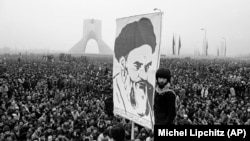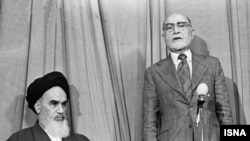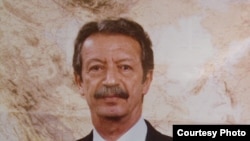Independence and freedom were two of the main promises of the Islamic revolution that changed Iran in February 1979.
All different groups opposing the Mohammad Reza Shah charged that his regime had made Iran subservient to the United States and deprived people of political freedom.
The man who led the revolution, Ayatollah Rouhollah Khomeini, promised freedom to the people in numerous interviews with Iranian and international media, and most believed him without having read a small book he had written a decade earlier, when he was living in exile in Najaf, Iraq.
In the book, The Islamic Government, Khomeini briefly mentioned the idea of Velayat-e Faqih, or the rule of the top religious leader, the underlying principle that brought about the post of the Supreme Leader, a figure who is authorized to undermine all democratic institutions and directly control the media, the armed forces, the Judiciary branch and indirectly intervene in all elections and the functioning of other institutions such as the Parliament and Presidency.
Radio Farda's editor-in-chief Niusha Boghrati in his program "The 6th Hour" asked dozens of listeners who phoned in during the program, as well as two political analysts, what happened to freedom as a result of the 1979 Islamic Revolution.
Khomeini had promised in 1979 that "from now on all men and women will be free unless they want to do something against the country's interests," and said that "all political parties will be authorized to operate freely."
In less than six months after he made the promises, he angrily took back his words about freedom of activity for political parties and civil liberties came under attack by his hardline supporters.
Asked if Iranians won their freedom as a result of the revolution and how would they compare the status of civil liberties before and after the 1979 revolution, Radio Farda listener Farid said; "Khomeini did not plan to promote freedom in the first place. He was a fundamentalist who wanted to establish a religious government. His successor is also continuing the same path. He misled people by his false comments about women's freedom and political freedom. People such as lawyer Nasrin Sotoudeh, human rights activist Nargess Mohammadi and dual national Nazanin Zaghari would have not been in jail if there was freedom in Iran."
Another listener, Omid from Karaj, said: "Before the revolution we had every freedom except political freedom. So, when people demanded freedom, they certainly meant political freedom. After the revolution, not only we did not get political freedom, we lost all other freedoms. Now, when we take to the streets to demand freedom, the Islamic Republic pretends that we want promiscuity."
Iranian commentator Saeed Barzin said that "at the time of the revolution both secular and religious opposition thinking was deeply anti-freedom, anti-liberal and pro-despotism." Some of the forces involved in the revolution had a Marxist idea about freedom, while Khomeini wanted a religious government. "The only moderate thought that supported freedom and democracy, was embodied in the administration of Prime Minister Mehdi Bazargan (first post-revolution prime minister), a mixture of leading members of the National Front and Freedom Movement liberal groups. Bazargan was the most important representative of liberal thought at that time," Barzin said, adding, however, that the prominent ideology at the time was the idea of despotism.
Another commentator, Reza Pirzadeh disagreed, saying: "The best person who at the time was able to defend freedom and democracy and push Iran toward liberal democracy was the Shah's last prime minister Shapour Bakhtiar. Unfortunately the National Front and other national forces including Bazargan turned their back to Bakhtiar and preferred to get close to Khomeini and work with him."
Pirzadeh added that from the time of the Constitutional Revolution of 1905 Iranians wanted independence and freedom and development, adding that Reza Shah and Mohammad Reza Shah Pahlavi secured the country's independence and moved it forward toward modernization. However, he pointed out that the idea of political freedom did not materialize under monarchy, although it was possible to reach to some sort of parliamentary democracy had reforms started.
Radio Farda listener Asgar Zadeh said he had studied abroad in Europe and returned to Iran upon his graduation where he tried to refine his traditional understanding of Islam by learning more form clerics, but he realized that clerics' idea of freedom was that people are free only to think like clerics. Otherwise, they do not believe in political freedom. He said Iranians were misled during the revolution because they did not know the clerics.
Moeen, another listener, said Khomeini's promises of freedom and welfare never came through, adding that Iranians had freedom under monarchy, but now they even fear the government when they want to phone in to talk on a radio show.
Kouhsari, said there were limitations in the area of cultural activities before the revolution although writers and poets enjoyed a greater degree of freedom than filmmakers. He added that except the last few years of Iran under monarchy, political freedom was generally restricted in the years before the revolution. He also pointed out that the Islamic Republic's opposition in its early years were as despotic as those who were in the government. However, he said that Iranians should have protested against the Islamic regime's excesses such as execution of previous regime's generals.
The two analysts also had some difference of opinion on the existence of freedom of expression in politics during the monarchy and in the Islamic Republic. Barzin believes that there is more open and public discourse now, while Pirzadeh says that public debate is only reserved for the inner circle of the regime and if anyone else dares to speak punishment is swift.
At the end of the discussion, another call-in participant who identified himself as Kavosh argued that during revolutionary agitation (1978) there was no discussion of what kind of freedom Iranians wanted. Communists had their definition of freedom and Islamists had a different concept. Even today, it is not clear what kind of freedom people want. Every person or group defines freedom differently, while the establishment keeps pretending it is split into factions; one group for more restrictions and another group in favour of not leaving things in place. In the end, Kavosh says Iranians might not reach more freedom.






